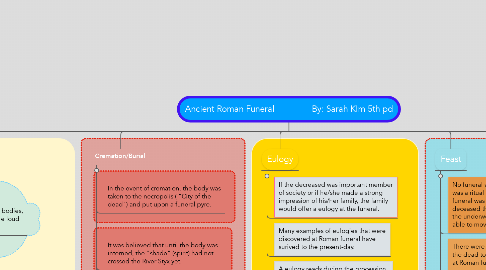Ancient Roman Funeral By: Sarah KIm 5th pd
by sarah kim

1. Procession
1.1. Marked by the movement of bodies, both living and dead, and the loud noise that it generated.
1.2. The movement wealthy and famous that decreased was in life, the flashier the funeral procession would be with mimes and musicians.
1.3. For the poor, perhaps only a few flute players would play music at the procession.
1.4. Professional mourners formed a large part of the procession. These were woman who were not members of the deceased's family.and be paid to participate.
1.5. Freedman, or clients of the deceased, also participated in the procession as a way of showing respect to their patron.
2. Eulogy
2.1. If the decreased was important member of society or if he/she made a strong impression of his/her family, the family would offer a eulogy at the funeral.
2.2. Many examples of eulogies that were discovered at Roman funeral have surived to the present-day.
2.3. A eulogy reads during the procession and occasionally after the funeral as in the funeral speech.
2.4. To thoes of person of high position, and the information gleaned from other sources is so scattered that there is great dangers of confusing usages of widely different times.
2.5. Then in the case of person of high position, there was ordinarily much less of pomp and parde than an occasions that the writers thought it worth while to describe.
3. Commemoration
3.1. Once the body was burried or cremated, the deceased still had to be remembered.
3.2. In Roman state set apart certain days each year to remember loved ones, including the Paren Talia, herd from February 13 &21 to honor the family's ancestors.
3.3. It was believed that if the deceased's family gathered around his/her tomb and made an offering, this would activate and placate the "shade".
3.4. There are large underground vaults where people cremated remains were placed within small wall niches, which were often marked by memorial plagues & portrait sculptures.
3.5. Roman believed that a proper burial was essential for passage to the afterlife, there was much concern on this score.
4. Cremation/Burial
4.1. In the event of cremation, the body was taken to the necropolis ( "City of the dead") and put upon a funeral pyre.
4.2. It was believed that until the body was interned, the "shade" (spirit) had not crossed the River Styx yet.
4.3. The body would be placed inside a coffin, called a Sarcophagus, which was often massive and richly decorated.
4.4. This was very old practice through the Mediterranean, but one that was hardly ever used in Rome, especially when cremation was the most common method.
4.5. In Roman Egypt, there was an incredibly life like painting of the decased attacted to the front of the Sarophagus.
5. Feast
5.1. No funeral was complete unless there was a ritual feast at the end of it. The funeral was the final marker that told the deceased that he/she could continue on the underworld and the family would be able to move foward.
5.2. There were food and drink offerings to the dead together with animal sacrifices at Roman funerals.
5.3. A scarfice of a pig was then offend, by which the place of burial was made sacred ground.
5.4. Food was eaten together by the mourners.
5.5. Spices and perfume were thrown upon them,together with gifts and token from the persons present.


